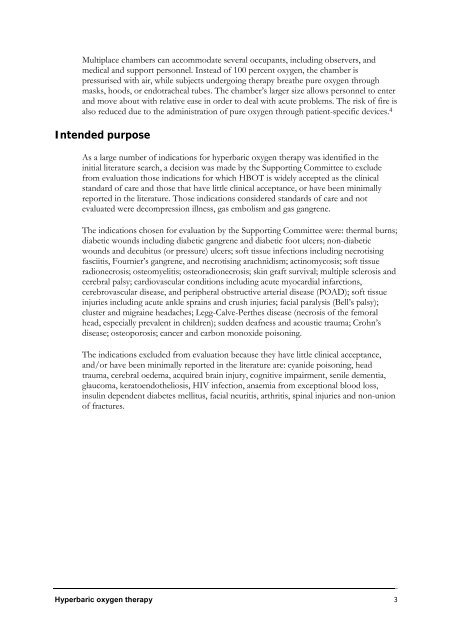Hyperbaric Oxygen Therapy - Hyperbaric Chamber Information ...
Hyperbaric Oxygen Therapy - Hyperbaric Chamber Information ...
Hyperbaric Oxygen Therapy - Hyperbaric Chamber Information ...
Create successful ePaper yourself
Turn your PDF publications into a flip-book with our unique Google optimized e-Paper software.
Multiplace chambers can accommodate several occupants, including observers, and<br />
medical and support personnel. Instead of 100 percent oxygen, the chamber is<br />
pressurised with air, while subjects undergoing therapy breathe pure oxygen through<br />
masks, hoods, or endotracheal tubes. The chamber’s larger size allows personnel to enter<br />
and move about with relative ease in order to deal with acute problems. The risk of fire is<br />
also reduced due to the administration of pure oxygen through patient-specific devices. 4<br />
Intended purpose<br />
As a large number of indications for hyperbaric oxygen therapy was identified in the<br />
initial literature search, a decision was made by the Supporting Committee to exclude<br />
from evaluation those indications for which HBOT is widely accepted as the clinical<br />
standard of care and those that have little clinical acceptance, or have been minimally<br />
reported in the literature. Those indications considered standards of care and not<br />
evaluated were decompression illness, gas embolism and gas gangrene.<br />
The indications chosen for evaluation by the Supporting Committee were: thermal burns;<br />
diabetic wounds including diabetic gangrene and diabetic foot ulcers; non-diabetic<br />
wounds and decubitus (or pressure) ulcers; soft tissue infections including necrotising<br />
fasciitis, Fournier’s gangrene, and necrotising arachnidism; actinomycosis; soft tissue<br />
radionecrosis; osteomyelitis; osteoradionecrosis; skin graft survival; multiple sclerosis and<br />
cerebral palsy; cardiovascular conditions including acute myocardial infarctions,<br />
cerebrovascular disease, and peripheral obstructive arterial disease (POAD); soft tissue<br />
injuries including acute ankle sprains and crush injuries; facial paralysis (Bell’s palsy);<br />
cluster and migraine headaches; Legg-Calve-Perthes disease (necrosis of the femoral<br />
head, especially prevalent in children); sudden deafness and acoustic trauma; Crohn’s<br />
disease; osteoporosis; cancer and carbon monoxide poisoning.<br />
The indications excluded from evaluation because they have little clinical acceptance,<br />
and/or have been minimally reported in the literature are: cyanide poisoning, head<br />
trauma, cerebral oedema, acquired brain injury, cognitive impairment, senile dementia,<br />
glaucoma, keratoendotheliosis, HIV infection, anaemia from exceptional blood loss,<br />
insulin dependent diabetes mellitus, facial neuritis, arthritis, spinal injuries and non-union<br />
of fractures.<br />
<strong>Hyperbaric</strong> oxygen therapy 3



